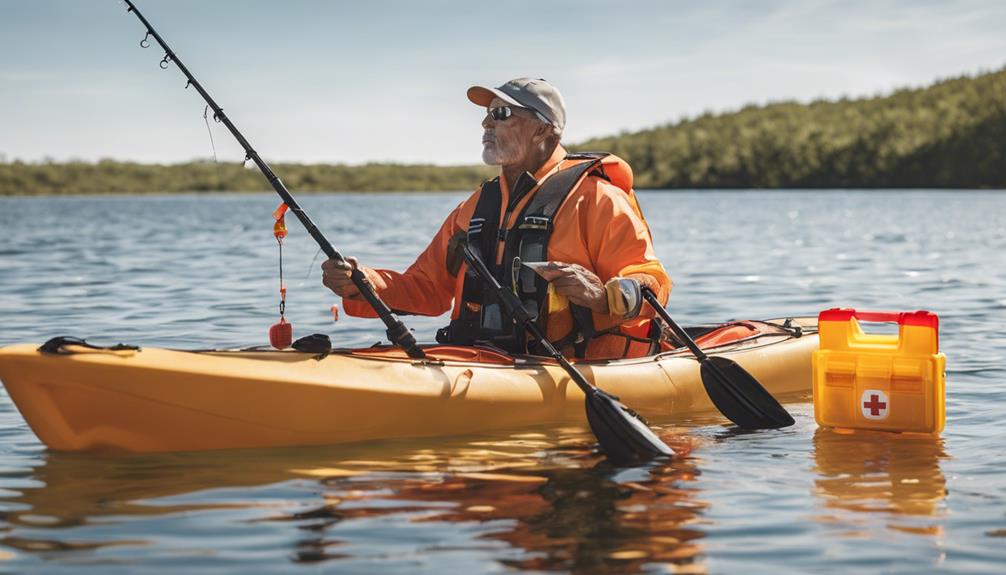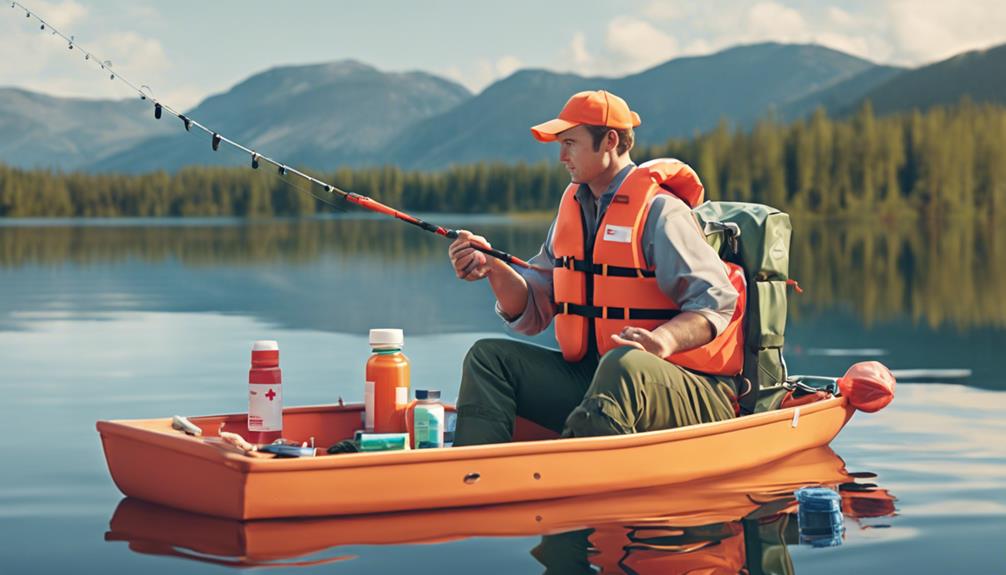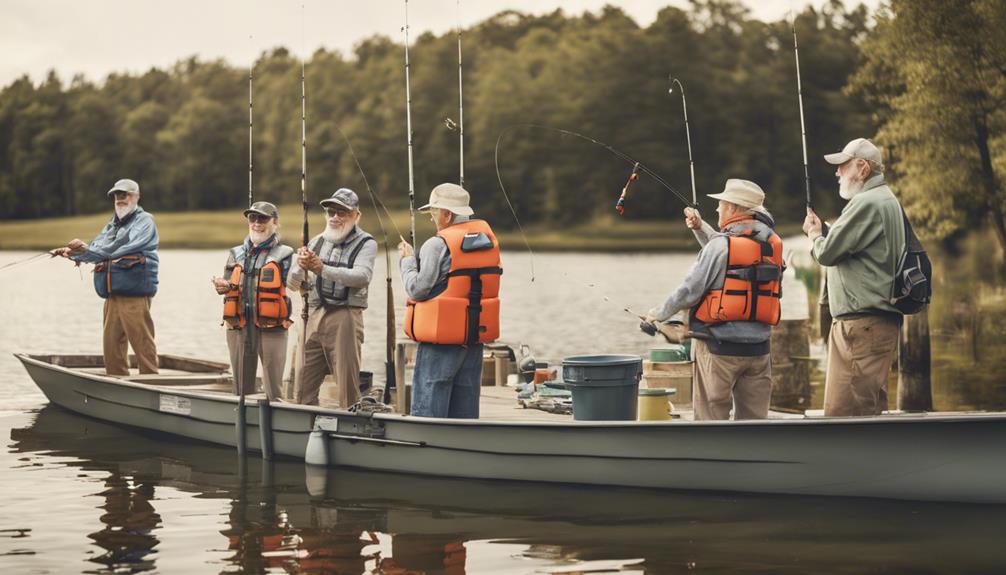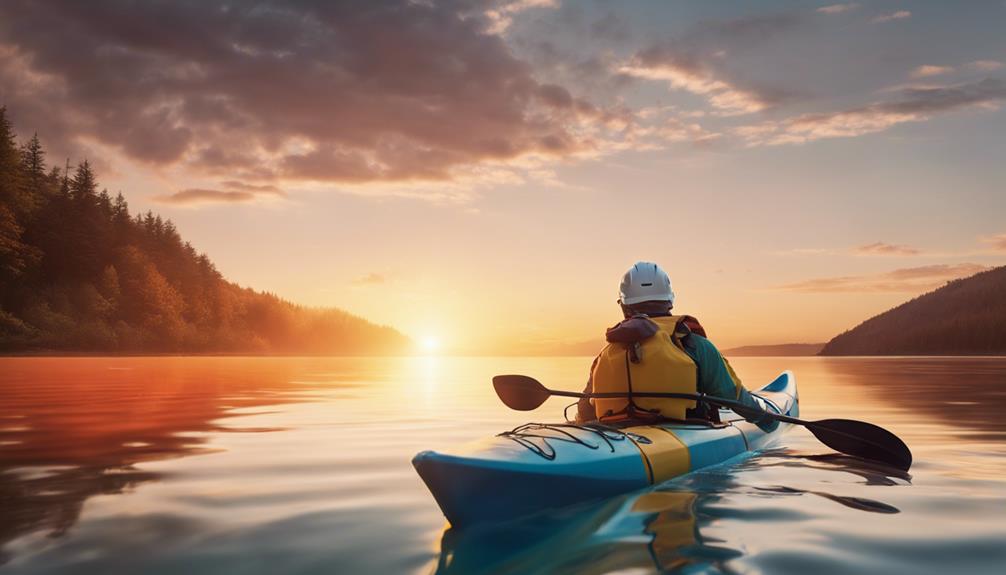When it comes to wildlife fishing, your safety is paramount. Picture this: you're out in nature, surrounded by the tranquility of the water, but are you truly prepared for all that comes with it?
From understanding local wildlife regulations to knowing how to handle unexpected emergencies, there are crucial safety measures you need to be aware of to ensure a successful and secure fishing experience.
Let's explore the essential precautions that will not only protect you but also the wildlife around you.
Importance of Wildlife Fishing Safety
Ensuring wildlife fishing safety is crucial for both protecting the environment and safeguarding yourself and others. By understanding the importance of wildlife habitat preservation, you contribute to maintaining a balanced ecosystem where various species can thrive. When fishing, it's essential to refine your techniques to minimize harm to the environment and ensure sustainable practices.
Preserving wildlife habitats is vital for the overall health of ecosystems. Fishing in a responsible manner helps prevent disruption to these habitats, allowing fish populations to remain stable and ensuring the survival of other species dependent on them. By being mindful of where you fish and how you handle the environment, you actively participate in conservation efforts that benefit both wildlife and future generations.
Refining your fishing techniques isn't only beneficial for the environment but also for improving your fishing success. Practicing proper catch and release methods, using barbless hooks, and avoiding lead sinkers can reduce harm to fish populations and their habitats. Additionally, learning how to properly handle fish for release decreases their stress levels and increases their chances of survival after being caught.
Incorporating wildlife habitat preservation and fishing technique refinement into your fishing practices demonstrates your commitment to being a responsible angler. By prioritizing these aspects, you contribute to the sustainability of ecosystems and help ensure that wildlife fishing remains a safe and enjoyable activity for everyone involved.
Understanding Local Wildlife Regulations
To ensure compliance with local wildlife regulations, familiarize yourself with the specific rules and restrictions governing fishing activities in your area. Understanding these regulations is crucial for not only avoiding fines but also for contributing to the conservation efforts and sustainable management of wildlife populations.
Here are some key points to consider:
- Permit Requirements: Before engaging in any fishing activities, make sure to obtain the necessary permits or licenses as required by your local wildlife authorities. These permits help track fishing activities and ensure that they're carried out responsibly.
- Conservation Efforts: Local wildlife regulations often have specific guidelines aimed at conservation efforts. By following these rules, such as catch and release practices or restricted fishing seasons, you can help protect the delicate balance of the ecosystem.
- Species Protection: Regulations may include restrictions on fishing certain species that are endangered or at risk. It's essential to be aware of these protections to prevent harm to vulnerable wildlife populations.
- Habitat Preservation: Fishing activities can impact the habitats of various species. Understanding and adhering to regulations that focus on habitat preservation, such as no-fishing zones or restrictions on certain areas, are vital for maintaining the health of the ecosystem.
Gear and Equipment Precautions
Before heading out for your wildlife fishing adventure, it's essential to consider important gear and equipment precautions to ensure both your safety and the well-being of the wildlife you encounter. Proper gear maintenance is crucial to prevent accidents and harm to the animals. Make sure to inspect your fishing equipment regularly, checking for any signs of wear and tear that could lead to malfunctions. This includes examining your fishing rod for any cracks, ensuring your fishing line isn't frayed, and confirming that your hooks are sharp and rust-free.
When it comes to fishing techniques, practicing catch and release can help minimize harm to the wildlife population. Use barbless hooks to make it easier to release fish without causing unnecessary injury. Additionally, avoid using live bait whenever possible, as it can harm fish if not hooked properly. Instead, opt for artificial lures or flies that are less harmful to the fish you catch.
Being mindful of gear maintenance and utilizing considerate fishing techniques not only ensures your safety but also promotes the conservation of wildlife. By taking these precautions, you can enjoy your wildlife fishing experience while minimizing negative impacts on the environment and its inhabitants.
Proper Handling of Fish
Handle fish carefully to minimize stress and potential harm during the catch and release process. When practicing wildlife fishing, it's crucial to consider the well-being of the fish you catch. Proper handling techniques can greatly increase the chances of survival for the fish once released back into their natural habitat.
- Use barbless hooks: Barbless hooks are easier to remove, causing less damage to the fish's mouth and minimizing stress during the unhooking process.
- Keep the fish in the water: If possible, avoid taking the fish out of the water as it can lead to oxygen deprivation and additional stress. Keep the fish submerged while removing the hook.
- Handle with wet hands: Wet your hands before touching the fish to prevent the removal of their protective slime layer, which helps fight off infections and parasites.
- Minimize handling time: Limit the time you handle the fish to reduce stress levels. Quick and efficient hook removal and release can significantly improve the fish's chances of survival.
Weather Awareness and Preparedness
Ensuring you're aware of the weather conditions and adequately prepared is essential for a safe and successful wildlife fishing experience. When heading out for wildlife fishing, always check the weather forecast beforehand. Be prepared for sudden changes by packing emergency shelters and survival kits in case of unexpected weather events.
Lightning safety is crucial when engaging in wildlife fishing. If you hear thunder or see lightning, seek shelter immediately. Avoid open areas, tall trees, and metal objects. If caught in a lightning storm, crouch down with your feet together, cover your ears, and wait for the storm to pass. Remember, safety comes first.
Hypothermia prevention is also key in ensuring a safe fishing trip. Dress in layers to regulate body temperature, and always carry extra clothing in case of wet conditions. Stay dry and keep moving to generate heat. In case of hypothermia symptoms like uncontrollable shivering or confusion, seek shelter, remove wet clothing, and warm up gradually.
First Aid and Emergency Protocols
In case of injuries during wildlife fishing, promptly administer first aid to ensure the well-being of yourself and others. Being prepared to handle emergencies can make a significant difference in the outcome of an unfortunate event. Here are some essential tips for first aid and emergency protocols:
- Stay Calm: In any emergency, staying calm is crucial as it allows you to think clearly and act effectively.
- Assess the Situation: Quickly assess the severity of the injury and determine the appropriate course of action.
- Contact Emergency Services: If the injury is severe or requires professional medical attention, call emergency services immediately.
- Provide Basic Wound Care: Clean and dress any wounds to prevent infection and promote healing.
Having a basic understanding of emergency response and wound care can prepare you to handle unexpected situations effectively. Remember, quick and appropriate actions can make a significant difference in ensuring the safety and well-being of everyone involved in wildlife fishing activities.
Wildlife Interaction Etiquette

When engaging in wildlife fishing, it's important to respect and adhere to proper wildlife interaction etiquette to ensure the safety of both the animals and yourself. Wildlife observation plays a crucial role in this activity. It's essential to maintain a safe distance from the wildlife you encounter while fishing. Observing animals from afar not only protects their natural behavior but also reduces the risk of startling or provoking them, which could lead to potentially dangerous situations. By practicing wildlife observation, you contribute to the preservation of their habitat and well-being.
Furthermore, practicing environment stewardship is key when interacting with wildlife during fishing trips. This involves being mindful of the impact your presence may have on the environment and its inhabitants. Properly disposing of any trash, avoiding the use of harmful fishing gear that could endanger wildlife, and respecting protected areas are all ways to show respect for the environment and the creatures that call it home.
Leave No Trace Practices
Practice responsible wilderness ethics by leaving no trace of your presence while engaging in wildlife fishing activities. Being mindful of your environmental impact and practicing ethical angling practices is crucial for the conservation efforts and sustainability of fishing techniques.
Leave No Trace Practices:
- Minimize Disturbance: Avoid altering the natural habitat when setting up your fishing spot. Choose durable surfaces like rocks or gravel to set up your gear instead of disrupting vegetation.
- Proper Waste Disposal: Carry out all your trash, including fishing line, hooks, and bait packaging. Dispose of waste properly to prevent harm to wildlife and maintain the cleanliness of the environment.
- Respect Wildlife: Keep a safe distance from wildlife and observe them without causing stress or disturbance. Don't feed animals as it can disrupt their natural behaviors and diet.
- Use Biodegradable Gear: Opt for biodegradable options whenever possible, such as biodegradable fishing line and bait. These choices reduce the long-term impact on the environment and marine life.
Frequently Asked Questions
Can Wildlife Fishing Have Any Negative Impacts on the Local Ecosystem or Wildlife Population?
When wildlife fishing, it's crucial to consider the potential negative impacts on the local ecosystem and wildlife population. Your actions can significantly affect wildlife conservation efforts and species preservation. Make sure to follow ethical practices and be mindful of the environmental impact of your activities.
How Can I Ensure That I Am Practicing Sustainable Fishing Practices While Out in the Wilderness?
To make sure you're fishing sustainably in the wilderness, start by checking catch limits and supporting conservation efforts.
Use sustainable gear and follow ethical practices like catch and release when needed.
By being mindful of your impact on the environment and wildlife population, you can help preserve the ecosystem for future generations.
Are There Any Specific Safety Measures That Should Be Taken When Fishing in Remote or Isolated Areas?
When fishing in remote areas, it's crucial to prioritize safety. Emergency communication and safety equipment are non-negotiable.
Make sure you have the necessary navigation skills and survival training to handle any unexpected situations.
Always inform someone about your fishing plans and expected return time.
Stay prepared with proper gear and knowledge to ensure a safe and enjoyable wilderness fishing experience.
What Should I Do if I Encounter a Dangerous or Aggressive Wild Animal While Fishing?
If you encounter a dangerous or aggressive wild animal while fishing, stay calm and slowly back away. Avoid direct eye contact and sudden movements.
If the animal approaches, make yourself appear larger and louder. Carry bear spray or a whistle for self-defense.
Always have a plan for emergencies in the wilderness. Remember to prioritize your safety and have a clear understanding of animal encounters and self-defense techniques while fishing in remote areas.
Are There Any Specific Precautions to Take When Fishing in Extreme Weather Conditions, Such as Strong Winds or Heavy Rain?
When facing extreme weather conditions while fishing, always prioritize safety. Be sure to check weather forecasts before heading out and stay informed about any potential changes.
In strong winds, secure your equipment properly and wear appropriate gear.
In heavy rain, seek shelter if possible and watch out for slippery surfaces.
Remember to always put your safety first and be prepared for any weather challenges you may encounter while fishing.
Conclusion
Remember, when engaging in wildlife fishing, safety should always be your top priority. By understanding local regulations, taking precautions with gear and equipment, handling fish properly, being aware of weather conditions, knowing first aid protocols, practicing wildlife interaction etiquette, and leaving no trace, you can ensure a safe and enjoyable experience on the water.
Always be prepared and respectful of the environment and the creatures you encounter while fishing. Stay safe and have fun out there!



